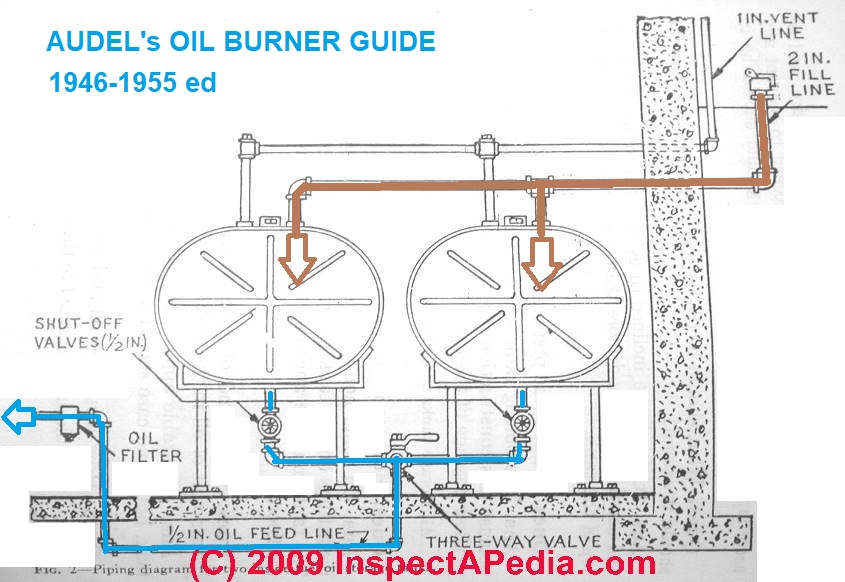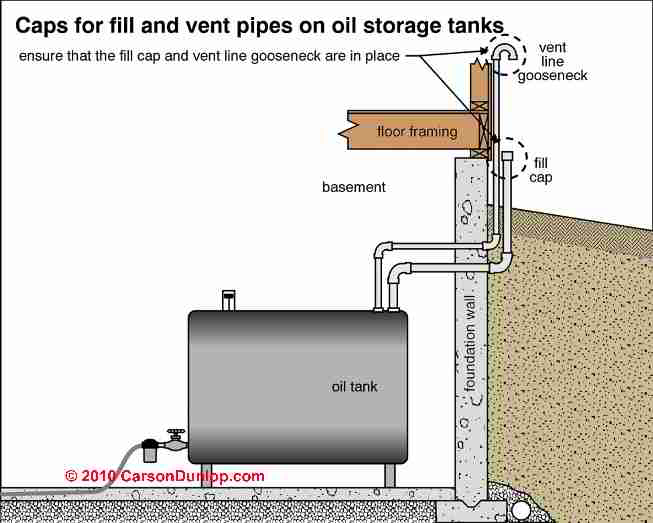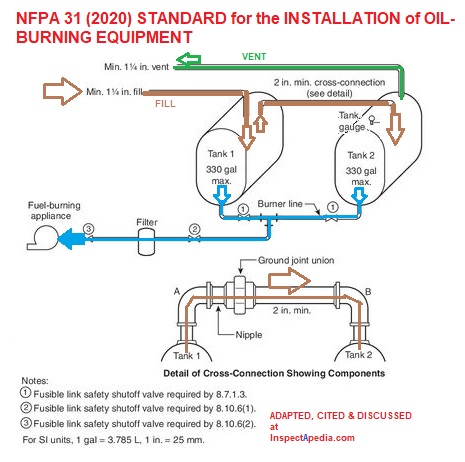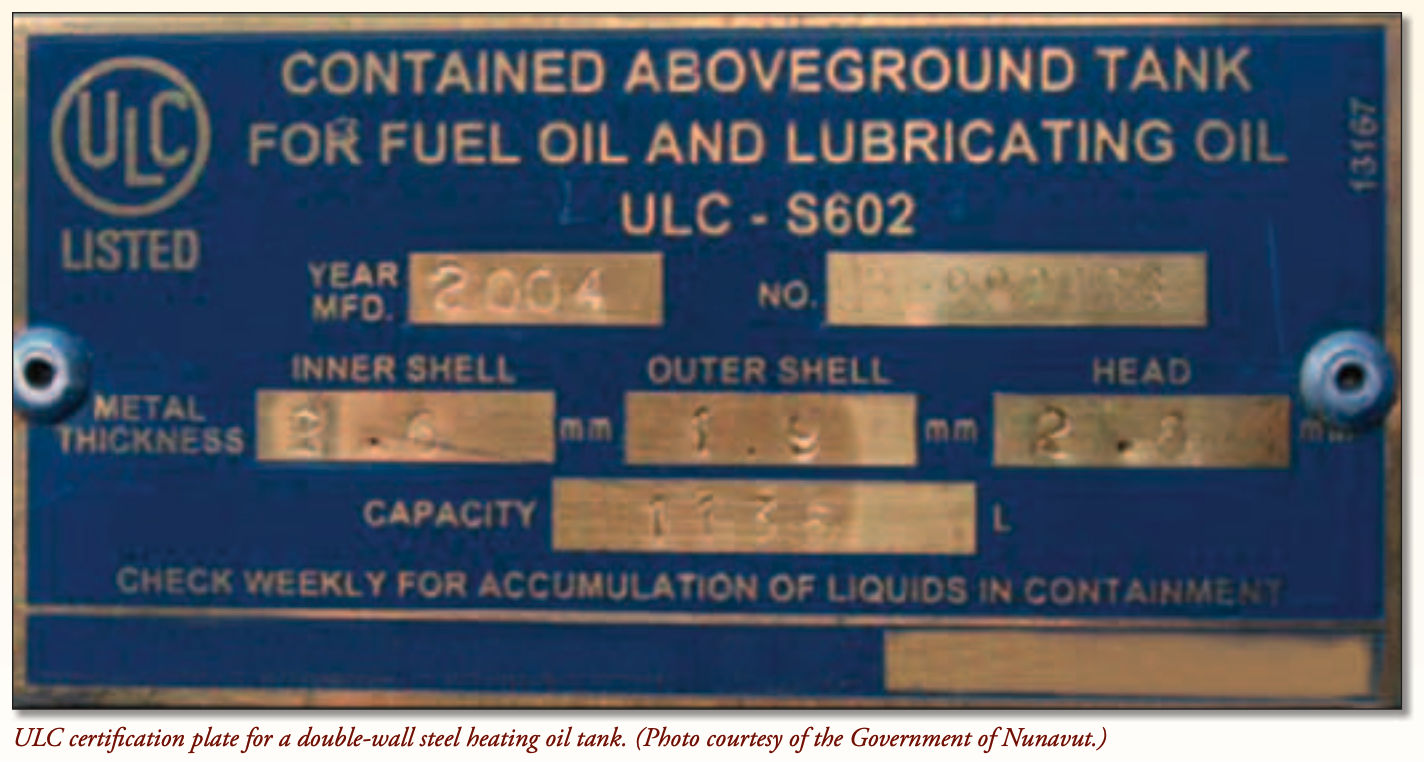 Guide to Heating Oil Piping for Duplex or Paired Oil Storage Tanks
Guide to Heating Oil Piping for Duplex or Paired Oil Storage Tanks
- POST a QUESTION or COMMENT about how to pipe or hook up dual or duplex heating oil storage tanks
Oil tank piping: how to hook up fill & vent & oil line piping on duplex or dual oil storage tanks: this document describes the typical piping arrangements for heating oil storage tanks:
how the oil tank fill, vent, and supply piping are arranged when two oil storage tanks (or more) are installed at a building.
InspectAPedia tolerates no conflicts of interest. We have no relationship with advertisers, products, or services discussed at this website.
- Daniel Friedman, Publisher/Editor/Author - See WHO ARE WE?
Typical Oil Tank Piping For Dual Oil Tanks Indoors
 Quick Guide to Fill and Vent Piping for Duplex Heating Oil Storage Tanks
Quick Guide to Fill and Vent Piping for Duplex Heating Oil Storage Tanks
At buildings where two heating oil storage tanks are installed, typically indoors, this AUDEL OIL BURNER GUIDE sketch shows the proper arrangement of fill piping, vent piping, and oil line piping leaving the tanks.
We have seen an alternative arrangement that provides a fill line only to the first tank, with the second tank filled by a second pipe exiting the top of the first oil tank - not an arrangement we recommend as this forces the first oil tank to be fully pressurized at the oil delivery truck pressure during fill-up of the second tank.
The piping shown in this Audel sketch is better. [Click to enlarge any image]
But
Watch out: The piping shown in this Audel sketch is at odds with recommendations from the NFPA 31 Standard for the Installation of Oil Burning Equipment (2020) as pointed out by several InspectApedia.com readers.
The fill piping will always fill the tank closest to the fill connection first, the tank will then overflow into the vent line and air from the second tank will at best blow oil droplets and vapors out of the vent pipe. At worst, the delivery operator will get an oil shower. - Anonymous by private email 2021/11/20 as illustrated below.
[Click to enlarge any image]
Here are more details of dual oil storage tank piping
Our photograph at page top of duplexed or a "pair" of oil storage tanks in a residential basement shows the most common oil fill, vent, and copper oil supply piping arrangement when two oil tanks are installed side by side at a building.
That installation, unlike the older Audel sketch, complies with more current dual oil tank installation piping suggested in NFPA 31 (2020) cited below.
Thanks to InspectApedia.com reader (prefers to remain anonymous), for technical editing & comments, November 2020.
Thanks to Arlene Puentes for technical editing, March 2010.
- The oil tank filler pipe
is connected to the first oil tank (the rear tank of the pair in our photo) at an oil tank top inlet fitting accepting a 2" diameter filler pipe. - A second tank top tapping
is used to continue the same diameter 2" steel piping out of the top of tank 1 and into the top of tank 2. - The oil tank vent pipe
is connected from the top of the second oil tank (the tank fully shown or "front most" in the oil tank pair in our photo) and routed outdoors to a location close to the filler pipe (so that the oil tank delivery driver can monitor the fill-up progress in the duplexed oil storage tanks. - The oil tank level gauge
is on tank #2 in our photo but would work equally well on either tank. - Copper oil supply piping
is connected at the bottom outlets of both oil tanks so that, as oil is drawn from this heating oil storage system, both tanks supply oil to the heating appliances, and thus the oil level will be the same in both tanks at all times.
A tee in the copper oil piping taps off of the common line between the two tanks to feed oil to the heating appliances in the building, where you will typically also see a shutoff valve (aiding in service such as changing the oil filter).
 At installations that include a fire safety valve at the oil tank (useful for service in this case), we like to see an additional fire safety valve at each oil burner oil supply line since that's a spot where a fire is more likely to occur.
At installations that include a fire safety valve at the oil tank (useful for service in this case), we like to see an additional fire safety valve at each oil burner oil supply line since that's a spot where a fire is more likely to occur.
See FIRE SAFETY CONTROLS.
As Carson Dunlop Associates' sketch (left) demonstrates,
- The fill and vent piping for oil storage tanks must be of adequate diameter (typically 2" filler and 1.5" to 2" vent though older tanks may use 1 1/4" vents),
- Properly located (vent not too distant from filler), and
- Protected against water entry or insect nest blockage of the vent line.
Thanks to reader D. B. Harlow for asking about how to make the proper connections to have two storage tanks, in parallel.
Thanks to Arlene Puentes for technical editing, March 2010.
Thanks to InspectApedia.com reader (prefers to remain anonymous), for technical editing & comments, November 2020.
Dual Oil Tank Piping References/Standards
Oil tank data tag from the Canadian Homeowners Guide to Oil Tanks, cited below, and courtesy of the Government of Nunavut. This tag certifies a double-wall steel oil storage tank.
- Canada: HOMEOWNER'S GUIDE to OIL TANKS [PDF] Canada, Northwest Territories Environment & Natural Resources, Web: enr.gov.nt.ca - retrieved 2021/11/20 original source: https://www.enr.gov.nt.ca/sites/enr/files/brochures/homeowners_guide_oil_tanks.pdf
- U.S. NFPA 31 Standard for the Installation of Oil Burning Equipment (2020) available from NFPA at https://www.nfpa.org/codes-and-standards/all-codes-and-standards/list-of-codes-and-standards/detail?code=31
Excerpt:
NFPA 31 is a standard for the safe, efficient design and installation of heating appliances that use a liquid fuel, typically No. 2 heating oil, but also lighter fuels, such as kerosene and diesel fuel, and heavier fuels, such as No. 4 fuel oil. NFPA 31 applies to the installation of these systems in residential, commercial, and industrial occupancies.
NFPA 31 - Standard for the Installation of Oil-Burning Equipment Scope
1.1 Scope.
1.1.1 This standard shall apply to the installation of stationary liquid fuel–burning appliances, including but not limited to industrial-, commercial-, and residential-type steam, hot water, or warm air heating appliances; domestic-type range burners; space heaters; and portable liquid fuel–burning equipment.
1.1.2 This standard shall also apply to all accessories and control systems, whether electric, thermostatic, or mechanical, and all electrical wiring connected to liquid fuel–burning appliances.
1.1.3 This standard shall also apply to the installation of liquid fuel storage and supply systems connected to liquid fuel–burning appliances.
1.1.4 This standard shall also apply to those multifueled appliances in which a liquid fuel is one of the standard or optional fuels. 1.1.5* This standard shall not apply to internal combustion engines, oil lamps, or portable devices not specifically covered in this standard. (See Chapter 11 for portable devices that are covered in this standard.)
A.1.1.5 Examples of portable devices not covered by this standard are blowtorches, melting pots, and weed burners.
...
Reader Comments, Questions & Answers About The Article Above
Below you will find questions and answers previously posted on this page at its page bottom reader comment box.
Reader Q&A - also see RECOMMENDED ARTICLES & FAQs
On 2021-11-24 by Margaret Umphrey - how to hook up a pair of outside oil tanks
I just purchased two residential oil tanks for use OUTSIDE my home I recently purchased. I live on a hill and it is difficult to get an oil tanker up the hill in the dead of winter I am told, (I live in northern NY now).
I found your installation guide for duplex or paired residential fuel oil tanks which is great but that info is for an INSIDE set up.
I don't have a clue about oil tanks, residential or otherwise. I already purchased 2 tanks to tide me through the winter in case the tanker can't make it up the hill.
The new oil tanks will be placed on a platform toward the front of the house and piped through an existing basement window. I am on my own, my husband passed away last December 2020.
If you or anyone can provide me with a little direction, it would be greatly appreciated. Thank you. Meg
On 2021-11-25 by Inspectapedia Com Moderator (mod) - how to add dual oil tanks above-ground outdoors at an existing home oil tank installation
@Margaret Umphrey,
I don't understand completely the installation arrangement as it sounds like both the tanks in your home and the tanks outside of your home or both right at the house. Perhaps you can post a sketch showing me what's going on.
Watch out: if your oil tanks are outside, in very cold weather you risk the loss of heat either from water in the oil tank freezing or from the heating oil itself waxing or gelling.
So you may have to buy a kerosene mix and discuss that concern with your oil delivery company.
There are other Solutions discussed in this article series.
Details are at HEATING OIL CLOUD WAX GEL POINT
Two oil tanks used outside would be connected together essentially in the same way as two oil tanks used inside. The common point of output from the oil tanks would still enter the house to feed an oil burner.
Watch out: however because your outdoor dual oil tanks will almost certainly be higher than your indoor oil storage tanks, your installer won't simply connect the oil lines together - doing that could cause the higher oil tanks to drain into the lower oil tanks by gravity, over-filling them and leading to a spill, perhaps at the fill or vent line for those tanks.
So more-likely your installer will connect the oil feed line that delivers oil to the burner to a Tee in the main oil burner feed line downstream from the indoor oil tanks.She'll then add shutoff valves so that when your indoor tank oil supply is quite low, say down to the last 1/8 of capacity, you'll want to manually close the feed valve from those tanks and open the feed valve from the upper tanks (or vice versa: if both are filled at the same time either pair of tanks can be chosen to be first-used).
Watch out: As you live in New York state, you'll learn that if you store more than 1,100 gallons of heating oil at your property, you will be required to register your oil storage with the New York DEC.
Quoting from the New York Code:
Businesses that store petroleum or petroleum products must register with the New York State Department of Environmental Conservation (DEC).
Registration is mandatory if the storage capacity is over 1,100 gallons.
Heating oil tanks that store less than 1,100 gallons are exempt from this registration requirement.
Contact
NYS Department of Environmental Conservation (DEC)
Division of Environmental Remediation, Bureau of Spill Prevention and Response
1 Hunter's Point Plaza
47-40 21st Street
Long Island City, NY 11101-5407Phone: (718) 482-4651
derweb@gw.dec.state.ny.usChemical or oil spills hotline: (800) 457-7362
Forms for registering bulk oil storage are at the NY DEC website https://www.dec.ny.gov/chemical/4767.html
Watch out: there are two concerns that make it important to get your oil piping and oil storage right:
1. risk of loss of heat and freeze/water/mold damage to your home
2. risk of leaking a large volume oil into your home or causing an oil spill outdoors - a costly environmental damage concern
Frankly, I worry that you may be buying things before getting advice that exactly fits your circumstance. Aboveground oil storage is less costly to install but has the waxing problem I cite. Did you consider having a single large 1000g buried tank installed?
Is your oil delivery company or oil heat service technician not coming to your house?
After all your oil burner needs annual service to be safe and reliable.
And it would be perfectly reasonable to discuss with the service manager at your oil service company sending an experienced technician who can help you plan the best way to provide additional oil storage.
On 2021-02-23 by Bob - Where is the vent alarm installed on dual oil tank installations?
Where in the dual oil tank illustration is the vent alarm installed? Is it installed in both tanks or just one? If it is in stalled in just one tank does it matter which tank it is installed in?
On 2021-02-23 by danjoefriedman (mod) -
@Bob, the vent alarm goes on the oil tank to which the vent fill-vent piping has been connected.
See details at OIL TANK GAUGE & VENT ALARM INSTALL / REPLACE
On 2020-05-20 17 by Archie - 1 fill and vent that serves both oil storage tanks.
Do l 2seperate fill pipes?
On 2020-05-21 by (mod)
No, Archie, you have 1 fill and vent that serves both oil storage tanks.
Normally the oil fill and vent are routed from outside to tank A and tank B is connected to A in series, both fill and vent, as shown in the drawings and photos above on this page.
You would want separate oil tanks with separate fill and vent pipes only at a building with separate oil fired heating equipment that is, for example, being used to supply separate occupancies and perhaps separate tenants, each of whom is paying for utilities separately.
On 2019-12-18 by Julie - I turned off 2nd oil storage tank to save fuel
We have duel fuel tanks I guess that run with each other . We turned off the second tank to try to save fuel was that a smart idea ?
I feel like its going faster with them both on. Once one tank is empty will it's automatically start using the second or are they both supposed to be running at the same time
On 2019-12-18 by DF: turning off second oil tank does NOT save fuel
Julie
The oil tanks simply provide fuel to your heater, they don't increase the rate at which it consumes oil.
So turning off the second tank won't save fuel.
But there are many ways that can significantly reduce your heating oil cost or use less fuel.
see
On 2019-02-17 by David - don't like oil lines run under concrete floor
Worth mentioning, the 2009 picture shows the oil feed being run under the concrete floor.
Home inspectors will have a problem with this especially during a purchase/sale of a home, because oil leaks are not visible and could lead to groundwater contamination. A better option would be to encase the oil feed in a separate pipe on top of the concrete.
On 2019-02-17 by (mod) - thaty opinion is useful but not authoritative factd
Thanks for the interesting opinion, David. We want to be careful to distinguish between what we think and what's authoritative or what's required by building codes and standards.
Your idea is one worth keeping in mind; still I'd argue (thus my OPINION not fact) that most heating oil leaks occur from either leaks in the steel tank body or leaks at poorly-made piping connections.
Worth noting:
Sandberg, Chet, Jim Holmes, Ken McCoy, and H. E. I. N. R. I. C. H. Koppitsch. "The application of a continuous leak detection system to pipelines and associated equipment." In Record of Conference Papers., Industrial Applications Society 35th Annual Petroleum and Chemical Industry Conference,, pp. 241-244. IEEE, 1988.
Berg, Jost. "Leak detection device for double-wall pipeline systems and container systems." U.S. Patent 6,489,894, issued December 3, 2002.
Interestingly none of the patents I could find cited any actual statistics on where oil leaks occur;
...
Continue reading at OIL TANK FILL & VENT PIPING INSPECTION CHECKLIST or select a topic from the closely-related articles below, or see the complete ARTICLE INDEX.
Or see DUAL OIL TANKS - PIPING FAQs - questions & answers about how to hook up dual heating oil tanks, posted originally at the end of this page.
Or see these
Recommended Articles
- OIL TANK CODES & STANDARDS - home
- OIL TANK GAUGE & VENT ALARM INSTALL / REPLACE
- OIL TANK INSPECTION & TROUBLESHOOTING - home
- OIL TANK PIPING & PIPING DEFECTS - home
- OIL TANK FILL & VENT PIPING INSPECTION CHECKLIST
Suggested citation for this web page
OIL PIPING for DUAL OIL TANK INSTALLATIONS at InspectApedia.com - online encyclopedia of building & environmental inspection, testing, diagnosis, repair, & problem prevention advice.
Or see this
INDEX to RELATED ARTICLES: ARTICLE INDEX to HEATING OIL, OIL BURNERS, OIL FIRED HEATERS, OIL TANKS
Or use the SEARCH BOX found below to Ask a Question or Search InspectApedia
Ask a Question or Search InspectApedia
Questions & answers or comments about how to pipe or hook up dual or duplex heating oil storage tanks.
Try the search box just below, or if you prefer, post a question or comment in the Comments box below and we will respond promptly.
Search the InspectApedia website
Note: appearance of your Comment below may be delayed: if your comment contains an image, photograph, web link, or text that looks to the software as if it might be a web link, your posting will appear after it has been approved by a moderator. Apologies for the delay.
Only one image can be added per comment but you can post as many comments, and therefore images, as you like.
You will not receive a notification when a response to your question has been posted.
Please bookmark this page to make it easy for you to check back for our response.
IF above you see "Comment Form is loading comments..." then COMMENT BOX - countable.ca / bawkbox.com IS NOT WORKING.
In any case you are welcome to send an email directly to us at InspectApedia.com at editor@inspectApedia.com
We'll reply to you directly. Please help us help you by noting, in your email, the URL of the InspectApedia page where you wanted to comment.
Citations & References
In addition to any citations in the article above, a full list is available on request.
- Thanks to reader D.B. Harlow for discussing parallel or duplex oil tank piping arrangement, October 2010
- Our recommended books about building & mechanical systems design, inspection, problem diagnosis, and repair, and about indoor environment and IAQ testing, diagnosis, and cleanup are at the InspectAPedia Bookstore. Also see our Book Reviews - InspectAPedia.
- "How do you choose the right tank testing method?", Cynthia Johnson, Fuel Oil & Oil Heat Magazine, November 1995
- "Homeowners Guide to Fuel Storage," Agway Energy Products, Verbank, NY, November 1990
- In addition to citations & references found in this article, see the research citations given at the end of the related articles found at our suggested
CONTINUE READING or RECOMMENDED ARTICLES.
- Carson, Dunlop & Associates Ltd., 120 Carlton Street Suite 407, Toronto ON M5A 4K2. Tel: (416) 964-9415 1-800-268-7070 Email: info@carsondunlop.com. Alan Carson is a past president of ASHI, the American Society of Home Inspectors.
Thanks to Alan Carson and Bob Dunlop, for permission for InspectAPedia to use text excerpts from The HOME REFERENCE BOOK - the Encyclopedia of Homes and to use illustrations from The ILLUSTRATED HOME .
Carson Dunlop Associates provides extensive home inspection education and report writing material. In gratitude we provide links to tsome Carson Dunlop Associates products and services.



